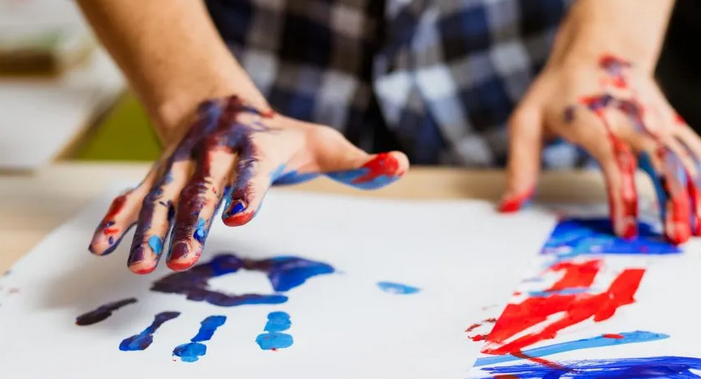Finger drawings, often associated with child’s play, have a remarkable secret: they can be a therapeutic tool for individuals of all ages. In this article, we explore the therapeutic benefits of finger drawings, shedding light on their capacity to promote emotional well-being and self-expression.

The Art of Finger Drawings
Finger drawings, a form of art therapy, allow individuals to create images using their fingers as brushes. This tactile experience is an expressive outlet that taps into deep emotions, offering solace and healing.
The Therapeutic Benefits of Finger Drawings
Stress Relief
These drawings provide an avenue for stress relief. The rhythmic motion of fingers gliding on paper or canvas can ease tension, promoting relaxation.
Emotional Expression
Moreover, these drawings serve as a non-verbal means of expressing emotions that may be difficult to articulate. The canvas becomes a safe space to convey feelings of joy, sorrow, or frustration.
Self-Exploration
Creating these drawings encourages self-exploration. Individuals can uncover hidden emotions and thoughts as they translate them into art.
Mindfulness and Focus
Engaging in these drawings requires concentration. This mindful focus can help individuals temporarily detach from daily stressors and achieve a sense of calm.
Social Connection
Group finger-drawing sessions can foster a sense of community and connection. Participants can share their creations, stories, and emotions, promoting empathy and understanding.
Body Awareness
Creating finger drawings fosters a deeper connection with one’s body. The tactile sensation of paint on fingers encourages individuals to be present in the moment.
Conflict Resolution
Finger drawings can be a means of conflict resolution in group therapy settings. Participants can express their grievances and work towards resolution through art.
Building Coping Strategies
Engaging in these drawings teaches individuals to develop healthy coping strategies. When faced with emotional challenges, they can turn to art as a constructive outlet.
Artistic Exploration
These drawings encourage artistic exploration beyond traditional forms. This unconventional approach to art can spark creativity and innovative thinking.
Cultivating Patience
Art therapy, including finger drawings, promotes patience. The process of creating detailed art requires individuals to slow down and focus on each stroke.
Start finger drawings with enthusiasm and creativity
Gather Supplies
All you need are basic art supplies: paper or canvas, non-toxic paints, and, of course, your fingers. A palette of colours adds vibrancy to your creations.
Create a Relaxing Environment
Find a peaceful space, play soothing music if desired, and arrange your supplies. Ensure you’re comfortable and free from distractions.
Start with Free-Form
Begin with free-form finger drawings. Let your fingers guide you without any specific image in mind. This promotes spontaneity and creative expression.
Explore Emotions
As you work on your drawings, explore the emotions that surface. Don’t judge or censor; simply let your fingers move.
Reflect and Interpret
After completing your drawings, take time to reflect. What do the colours and shapes signify? This self-interpretation can be enlightening.
Case Studies: Real-Life Benefits
Anxiety and Stress Relief
Sarah, a young adult dealing with anxiety, found solace in finger drawings. The act of painting abstract swirls and patterns allowed her to release pent-up stress, leading to more peaceful nights.
Trauma Recovery
Finger drawings played a crucial role in John’s journey of trauma recovery. Through his art, he gradually processed and externalized his traumatic experiences, moving towards healing.
Children and Self-Expression
Children often struggle to express complex emotions verbally. Finger drawings offer them a creative outlet to communicate feelings and gain a sense of control.
Guided Finger Drawing Sessions
Children often struggle to express complex emotions verbally, but these drawings provide them with a creative and tactile outlet. Through this form of self-expression, children not only communicate their feelings but also gain a sense of control over their emotions and experiences. These drawings can serve as a therapeutic tool, helping children process and make sense of their inner world in a visual and engaging way. This artistic expression allows them to explore their thoughts, fears, and joys, fostering emotional development and self-discovery. Additionally, it offers parents and caregivers valuable insights into a child’s emotional state, creating opportunities for meaningful communication and support.
Finger Drawings as a Form of Art Therapy
It encourages individuals to engage with their emotions in a non-threatening manner.
Art Therapy and Professional Guidance
This form of therapy is particularly beneficial for individuals dealing with trauma, grief, or major life changes.
The Healing Power in Your Hands
Finger drawings are more than just colourful swirls on paper; they are a gateway to emotional healing and self-discovery. By simply dipping your fingers in paint and letting your emotions flow, you can embark on a therapeutic journey that nurtures your mind and soul.
Conclusion
In conclusion, finger drawings, accessible to anyone willing to pick up a paintbrush, or in this case, use their fingers, offer a unique path to emotional expression and healing. By allowing emotions to flow through art, individuals can find solace, reduce stress, and embark on a journey of self-discovery. So, why wait? Dip your fingers into the world of finger drawings, and unlock the therapeutic benefits that lie at your fingertips.

